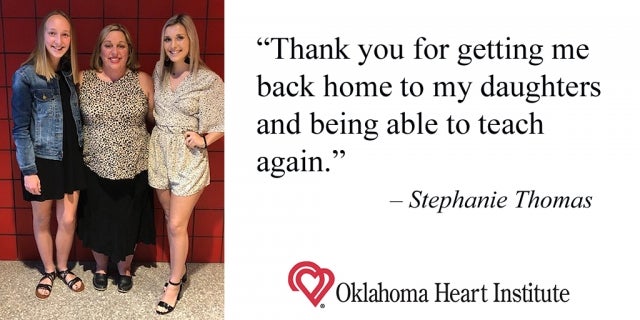For Stephanie Thomas, the flu-like symptoms were very familiar as she recuperated at home. However, as the symptoms persisted and her breathing became more difficult, she was admitted to a local hospital and placed on a respirator.
Diagnosed with COVID-19, her breathing steadily declined over the next two weeks. Describing her situation, Thomas said, “I was down to my last resort.”
That’s when Ajit Tharakan, M.D., cardiothoracic surgeon at Oklahoma Heart Institute, and the extracorporeal membrane oxygenation (ECMO) team picked up Thomas in Grove, transported her to Tulsa and placed her on an ECMO machine to help her breathe.
“Stephanie’s case is a good example of just how terrible this virus can be,” said Adam Betz, M.D., medical director of the ECMO program at Oklahoma Heart Institute. “With COVID-19, there are some people who recover fully and some who die no matter what you do. But there is a very large group in the middle who, like Stephanie, get what appears to be long-term lung damage. They recover just enough to come off ECMO, but the symptoms last much longer.”
According to Betz, since the virus is still relatively new, there is not enough research and compiled data on the long-term effects of the disease.
“No one knows yet how to predict who will do what and we do not know to what extent a patient’s lung function will get better over time,” he said.
Thomas, 44, an early childhood reading teacher for the past 20 years, improved on ECMO faster than most patients.
“Our average for patients to be on ECMO is three weeks,” said Betz. “She came off ECMO in two weeks, but had very slow progress afterward. She stayed with us another three weeks, slowly weaning off a ventilator until she was at a very low oxygen setting. By then she was working well enough with physical therapy to be discharged to a long-term acute care center.”
Over the next couple of months, Thomas stayed at the long-term acute care center to finally wean off the ventilator and to begin physical therapy. She then moved to an inpatient rehabilitation center where she had extensive physical therapy.
After completing physical and occupational therapy, Thomas was breathing well enough to return home after four long months. Her therapy continued, however, as she had lots of physical and occupational therapy at home, in addition to home health care.
“I’m still on medications, lots of vitamins and two liters of oxygen,” said Thomas. “But I am back to teaching virtually. I teach kindergarten and my school district is letting me teach students on Zoom from home until the end of the year.”
Her holidays last year were much happier because she could spend them at home with her daughters.
“My daughters are 13 and 18 and they're the best blessings ever,” Thomas said. “I’m so thankful to my family, who cared for the girls while I was in the hospital.”
When asked about the care she received, Thomas said, “Oklahoma Heart Institute is an exceptional place that provides loving care. I just want everybody on the ECMO team – I don't even know who all of them are – to know that they took the very best care of me. I'm so grateful. I wouldn't be here if it wasn't for them.”
For more information about ECMO, please visit oklahomaheart.com/ecmo.

